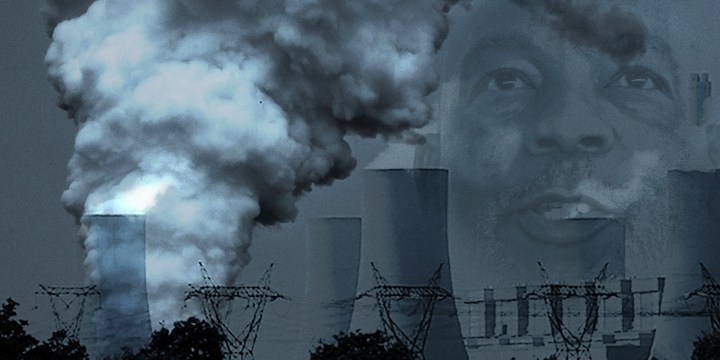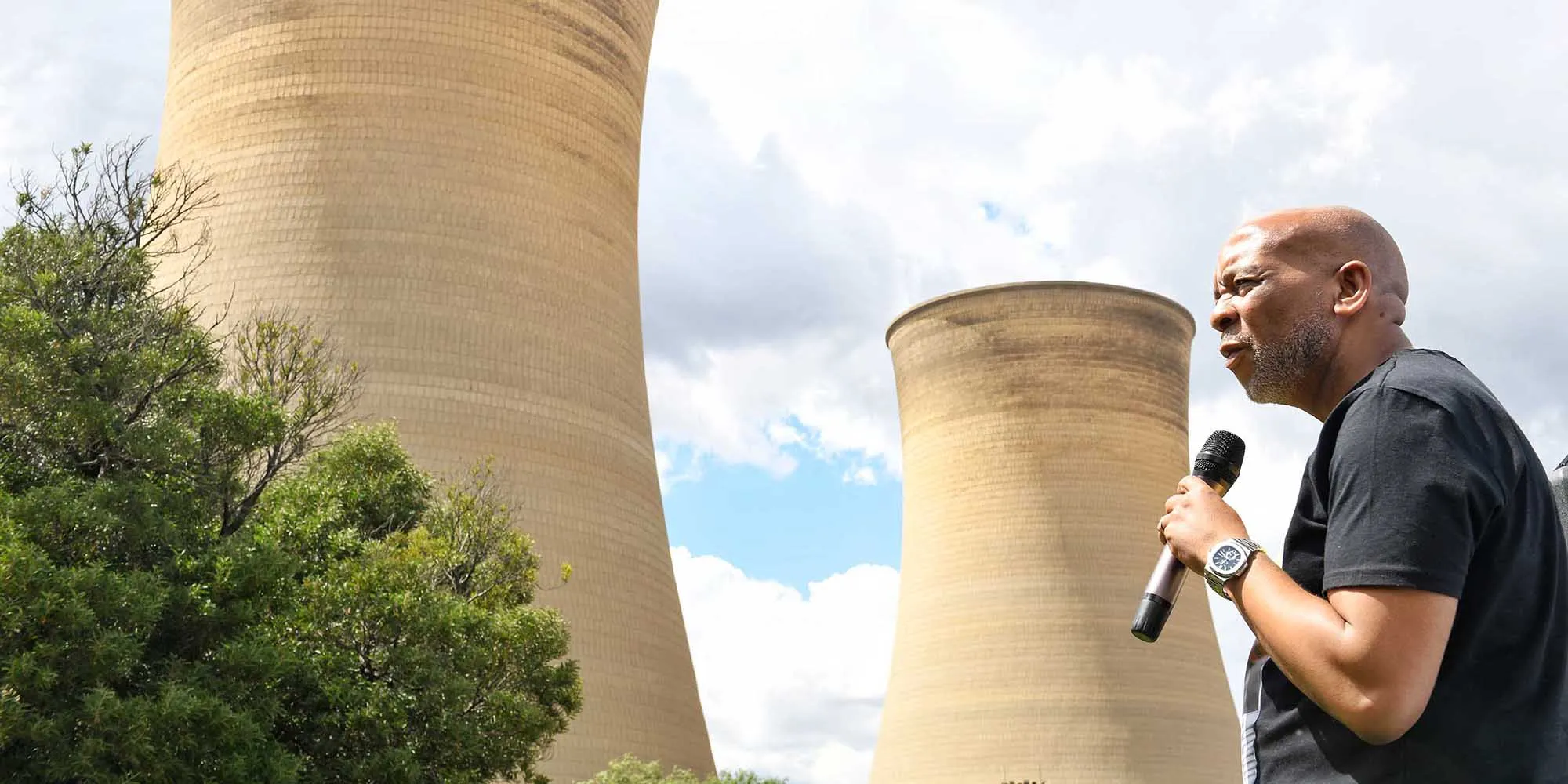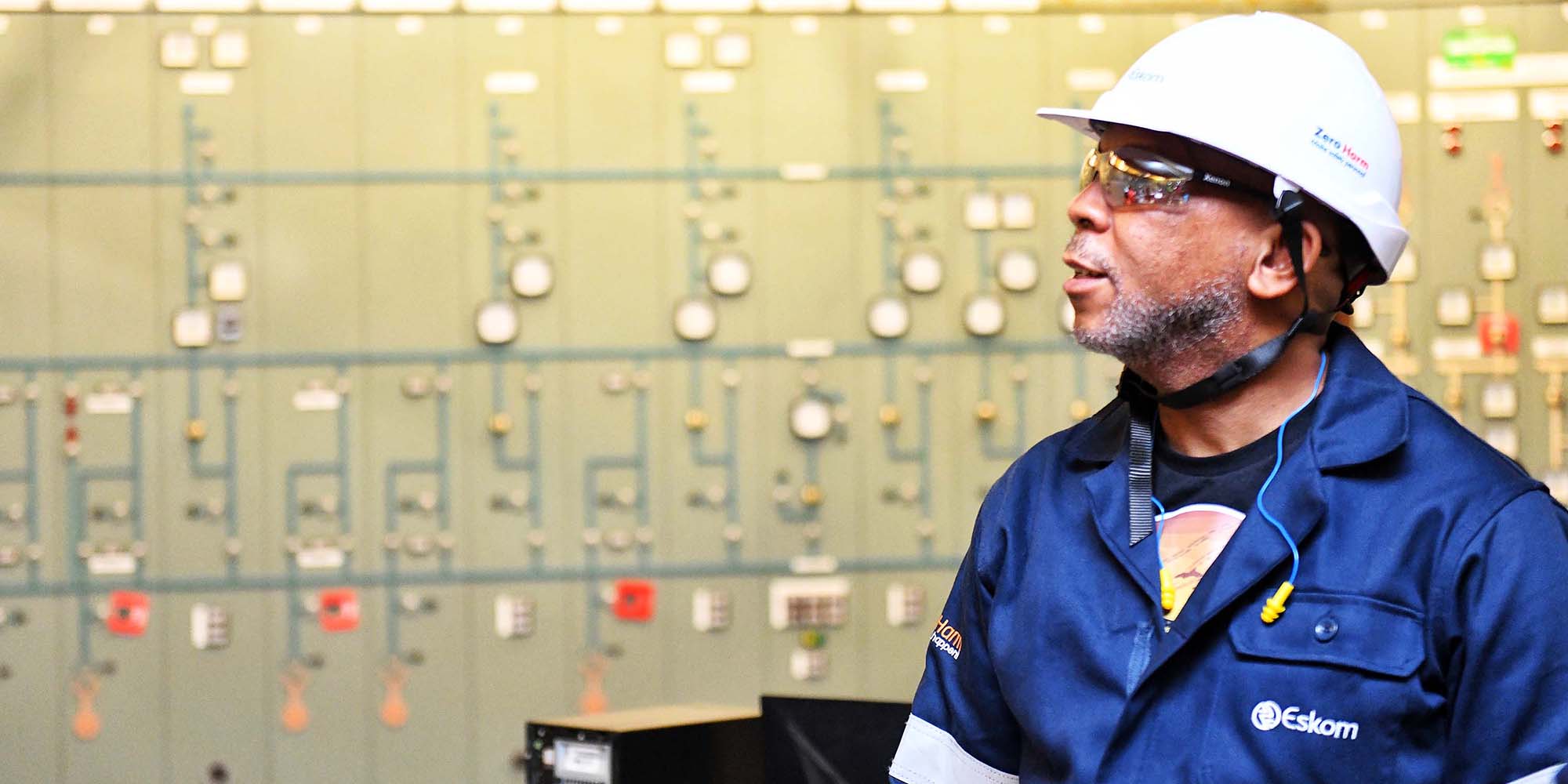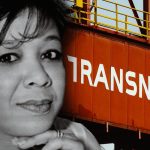ENERGY CRISIS OP-ED
Does Ramokgopa really need more powers to end load shedding?

If it is accepted that the absence of policy coherence and an associated political settlement is the problem that the minister of electricity should address, then allocating powers to him becomes a moot point.
South Africans seem to be obsessed with whether or not the minister of electricity has been empowered by President Cyril Ramaphosa to end load shedding. This is unsurprising because we all desperately want someone in authority who talks sense and who has the actual power to bring load shedding to an end. It rests on the assumption that if you have power, you can resolve the problems. But is this really true? Maybe we need to be asking different questions.
Up until now Minister of Mineral Resources and Energy Gwede Mantashe has failed to inspire confidence within society in general and business circles in particular that he is the man to bring lasting solutions. After all, until André de Ruyter’s departure he would always repeat the same line: there is plenty of energy available in South Africa to end load shedding, Eskom just needs to flick the switch to bring it onto the grid. By implication, Eskom was not flicking the switch because it had a hidden agenda – eventually, he came out and said what this hidden agenda was: treason.
But very few South Africans outside certain ANC factions believed this story. After all, there are tens of thousands of South Africans who work in coal mines and power stations, and who are subcontractors and consultants to Eskom of various kinds, who knew better from first-hand experience. They talk, and it ripples out into society.
Kgosientsho Ramokgopa did what Gwede Mantashe said no minister had ever done – visit all the power stations. He then presented his analysis at a one-and-a-half-hour press briefing where, without the aid of PowerPoint and without reading from prepared notes, he presented his findings (including snarky asides about why the “state of disaster” is not required). In short, he said what Mantashe has never said – he admitted that the power stations were, indeed, in deep trouble. He said billions would be needed to repair them and that he would go to Cabinet with a budget.
Before the Cabinet meeting, the minister of finance quickly reiterated his February 2023 Budget Speech by stating clearly that there are no funds to fix the machines. Since then, Ramokgopa has repeatedly explained to the nation why we have load shedding – fully accepting the validity of the technical information provided by Eskom, he uses every opportunity to explain in painstaking detail why load shedding happens, why we are going into higher stages and why things will get tougher this winter. Not only is this new style refreshing after years of obfuscations and contradictory messaging from politicians, it should be welcomed and reinforced. Above all, it helps build trust – a precious, scarce property that has been systematically eroded in recent years.
It is clear that Ramaphosa has always seen this new minister in his office responsible for electricity as the person with the primary mandate for ending load shedding. During his speech when he announced the position he went off script and said: “I need help.” He was referring to the help he needs to implement the resolution from the ANC’s December 2022 conference mandating him to end load shedding. To this end, Ramaphosa announced at the end of May that he was allocating powers to his minister of electricity that would specifically empower him to execute his mandate.

Electricity Minister Kgosientsho Ramokgopa at the Hendrina power station in Mpumalanga on 30 March 2023. (Photo: GCIS)
Although there is evidence that he intended to allocate sections 34 (1) and (2) of the Electricity Regulation Act (ERA) to this new ministerial position, in the end it seems Mantashe intervened to ensure that he retains control of 34 (2). This has left Ramokgopa with the rather limited power to issue determinations of the future energy mix that South Africa requires (with most of the big determinations already issued in 2022). Although he has interpreted this to mean he is in control of the drafting of the Integrated Resource Plan (which, after all, does specify the future energy mix), it would appear this is technically not true. By retaining control of Section 34 (2) and the rest of the ERA, Mantashe retains control of procurement, energy planning (including the IRP), the IPP Office as well as provisions relating to key load shedding solutions such as embedded generation, rooftop solar, Karpowerships and back-up/storage facilities. In short, everything that is needed to end load shedding.
So, how worried should we be that the minister of electricity does not, in fact, have significant legal powers to ensure that load shedding ends sooner rather than later?
A lot depends on what you think the problem is. In my view, the problem over the past two decades, during which Eskom went from being named the best energy utility in the world in 2001 to being one of the worst performers, is, in fact, the absence of policy coherence. By this I mean the absence of a political settlement between ANC factions and key power centres within the state system as to how best to manage Eskom and, in recent years, how best to respond to the global energy transition which has resulted in the drying up of investment capital for large-scale coal-fired power. If I am correct, then the solution lies in building that political settlement that will, in turn, result in policy coherence and joint, purposive action.
In recent years, Ramaphosa has appointed two significant bodies and a task team with clear-cut mandates to build the policy coherence that is needed to ensure effective implementation. These are the Presidential Climate Commission (PCC), established in 2020, the National Electricity Crisis Committee (Neccom), which got going in 2022, and the Climate Finance Task Team led by Daniel Mminele that was set up after the COP26 meeting in Glasgow at the end of 2021.
Read more in Daily Maverick: Six SA energy crisis solutions happening now, or (hopefully) soon
Policy coherence, however, depends on a political settlement between powerful political and bureaucratic players as to the overall goal and directionality of change. While key people in the PCC and Neccom have the appropriate network links for influencing such a political settlement, this is not sufficient to make it happen. The electricity minister, however, can make it happen. And for this, it is not formal powers that he needs, but the capacity to facilitate strategic alignment and a shared vision of the future within a highly contested and conflictual space.
The PCC’s mandate is to broker a multistakeholder policy agreement on how best to decarbonise the South African economy in a way that will achieve energy security at the lowest possible cost. There are a range of Cabinet-approved policy frameworks that mandate this goal, but it is only the PCC that has a permanent group of commissioners and a secretariat that is working away at strategies for how to achieve this goal.
The policy frameworks that mandate the twin goals of energy security and net zero include the 2019 Integrated Resource Plan (IRP) that clearly stipulates the need to decommission 25% (11GW) of installed generation capacity by 2030 (and this goal, by the way, was not imposed by Western nations as a condition for the $8.5-billion funding, as many influential political players suggest without any evidence). The other Cabinet-approved policy frameworks that reinforce this goal include the Low Emission Development Strategy (LEDS), the National Infrastructure Plan 2050 (NIP 2050), the Nationally Determined Contribution (NDC), the Just Transition Framework (JTF) and the Just Energy Transition – Investment Plan (JET-IP). The Climate Change Bill will, hopefully, formalise South Africa’s commitment to climate action and regularise the role of the PCC.
Set up in 2022, Neccom’s mandate was to formulate the Energy Action Plan (EAP) for adoption by Cabinet. Supported by Operation Vulindlela in the Presidency, Neccom has become the most significant centre of policy coherence with respect to the immediate goal of ending load shedding. Comprising specialists from many disciplines and backgrounds and heavily supported by private-sector expertise, Neccom has basically become the nerve centre of a coalition of policy and technical experts supporting the implementation of the EAP.
What Ramokgopa does need is extraordinary political skills for brokering agreements, a media savviness that builds trust, and a stomach of steel to deal with the ruthless and seasoned political players in the energy space.
The primary job of the Climate Finance Task Team was to draft the JET-IP that was approved by Cabinet and presented by André de Ruyter at COP27 in Egypt in late 2022. This plan was consistent with the IRP and NDC and the JTF. The next step is to raise the funding.
While the public discussion has been about the $8.5-billion (R130-billion) from Western donors, the real significance of the plan was missed – this was the estimate that R1.5-trillion is needed for the five years to 2027. If only R130-billion is to be raised internationally, the rest (yes, R1.37-trillion!) must be raised internally from South African public and private investors. That level of investment in fixed infrastructure would catalyse a new growth path for South Africa.
The PCC and Neccom, however, are facilitators of policy coherence, but that does not mean they can assume that there is a political settlement that protects the policy space needed to ensure rapid implementation. If such a political settlement existed, the work of the PCC and Neccom would be that much easier and implementation would follow. But it is questionable whether such a political settlement is in place. When it comes to implementation, this kind of political vacuum can be problematic, even dangerous.
What is significant about the way Ramokgopa is now playing his hand is that he is starting to fill this vacuum with what could mature into a full-blown political settlement. Does he need formal powers to achieve this? I am not so sure. What he does need is extraordinary political skills for brokering agreements, a media savviness that builds trust, and a stomach of steel to deal with the ruthless and seasoned political players in the energy space who may have no interest in a robust political settlement on how best to manage Eskom and harness the energy transition. A weak President does not help.
Root cause of blackouts
The absence over two decades of a political settlement on the future of Eskom is the root cause of load shedding. The Cabinet-approved 1998 White Paper that recommended a new-build programme wasn’t implemented for a decade, prompting President Thabo Mbeki to eventually apologise to the nation in 2007 for ignoring Eskom’s repeated requests to build a new power station.
As the Zondo Commission has made it abundantly clear, during the Zuma years Eskom became the feeding trough for the State Capture faction of the ANC that National Treasury tried in vain to resist under the leaderships of ministers Nhlanhla Nene and Pravin Gordhan. In 2015, Eskom was politically instructed to refuse to sign the power purchase agreements for 5GW of renewable energy promoted by the IPP Office in the Department of Energy that would have prevented most of the load shedding we have today.
The reason we become exasperated by the failure to allocate meaningful powers to the minister of electricity is that we undervalue the art of political settlement making as the most important precondition for effective implementation.
Since 2019, Ramaphosa has consistently failed to broker an agreement between the two ministers responsible for the energy system – the ministers of public enterprises and of mineral resources and energy. Even his breakthrough energy plan of July 2022 that became the basis of the Cabinet-approved Energy Action Plan was undermined at various points by Mantashe. While Ramaphosa commended and supported the Eskom management in his July 2022 statement, not long after Mantashe accused Eskom of treason, Gordhan responded by defending De Ruyter.
So, will our Sparky in Chief be able to broker a political settlement that will enable the policy coherence emerging from the work of the PCC and Neccom to be implemented in ways that bring load shedding to an end? And does he need formal powers to get the job done?
Read more Eskom news and analysis here.
The reason we become exasperated by the failure to allocate meaningful powers to the minister of electricity is that we undervalue the art of political settlement making as the most important precondition for effective implementation. This is the key insight emerging from a new body of academic literature that documents the actual causes of governance failures and successes. Known as the “political settlements” literature, the scholars writing in this tradition have broken away from the structuralist assumptions of the more fashionable literature on the “developmental state”. Instead of assuming that “getting the structures of the state right” is a precondition for successful implementation of industrial policies, these scholars (most from the Global South) home in on the granular institutional dynamics of building centres of effectiveness that result in impactful implementation. In every case where this has happened, a political settlement between key political factions and bureaucratic elites was facilitated that protected the space for the emergence and survival of these centres of effective implementation. Implementation is less about structure and rules, and more about the politics that enable it to happen.
The electricity minister seems to not only understand renewables, he also seems to have realised that he has much to gain from riding the Tsunami of new renewables that is well on its way.
After some initial rash statements that were out of line with Cabinet-approved policies, Ramokgopa is articulating a raft of policy interventions that could well achieve what the President was mandated by the ANC conference to achieve, i.e. the end of load shedding in two years. He has somewhat muted his initial grand claims that fixing the machines can end load shedding and confirmed De Ruyter’s claims about corruption and sabotage. He has called for 15GW of renewables, which would be on top of the 16GW to 20GW announced in 2022 and referred to in the Energy Action Plan. He has made sensible statements about limiting the Karpowerships contract to five years (if it ever manages to get through the regulatory hoops). He has supported calls to rapidly increase investments in the transmission grid. He has even breathed new life into calls for more ambitious demand management. And he has strongly supported the rooftop solar programme that received a major boost via tax incentives announced in the finance minister’s Budget speech in February. To implement them all, a political settlement will be needed that this is the direction all key power players need to follow.
The electricity minister seems to not only understand renewables, he also seems to have realised that he has much to gain from riding the Tsunami of new renewables that is well on its way. According to the Energy Action Plan, there are more than 9GW of approved embedded generation projects, with rocketing numbers of new Nersa registrations of these installations (985 projects with a combined capacity of 4.8 GW by end of Q1 2023). This is on top of the 6.2GW of renewables that have been constructed via the REIPPPP since 2011 and the 10GW of new renewables that will be procured via bid windows 6 and 7 of the REIPPPP recently announced by Mantashe.
But most stunning of all is the rapid uptake of rooftop solar. In its May 2023 Financial Stability Report, the South African Reserve Bank reports: “There is growing evidence to suggest that households and firms are investing in alternative energy sources to mitigate the effects of more severe load shedding, although at the expense of other priorities. Generator imports (at constant prices) were at multiyear highs in 2022 (Figure 32), while the first quarter of 2023 saw solar panel imports of around R3.2-billion (at constant prices), compared to approximately R1.4-billion during the first quarter of 2022.” There is some evidence that there might already be more rooftop solar than the total existing fleet of utility-scale renewables. Some estimate that 7.5GW of rooftop solar could be constructed within the next 18 months.
The game changer here might be the normalisation of Stage 6: this turning point, more than anything else, has pushed the undecided over the line, triggering a massive and irreversible demand by businesses in particular for rooftop solar systems with battery back-up. And because of the Budget speech, much of this expenditure will be compensated for via tax incentives.

Electricity Minister Kgosientsho Ramokgopa visits Hendrina Power Station on 30 March 2023. (Photo: GCIS)
Although only 10GW of new renewables are needed to end load shedding in 24 months, if all the renewables in the pipeline are added up, we can anticipate far more than this to materialise in the next two to three years. This would far exceed the JET-IP target of 5GW of new renewables per annum. However, what we are witnessing is a disorderly transition in reaction to state failure to prevent load shedding. It will be anything but just. Those who have money can afford what it takes to survive a disorderly transition.
In short, if it is accepted that the absence of policy coherence and an associated political settlement is the problem that the minister of electricity should address, then allocating powers to him becomes a moot point. It is also arguable that he has already changed the ball game without having these powers. That said, there is one major change that would make a big difference: if he was given control of the soon-to-be-completed IRP. It’s easy to achieve – the President simply has to tell Mantashe that Ramokgopa is in charge of the IRP.
All indications are that the draft that will be published by the Department of Mineral Resources will go up against current mainstream trends and the emerging political settlement that Ramokgopa is assembling by advocating delusional techno-fixes such as “clean coal” and “small modular reactors” (SMR), neither of which have been proven to be commercially viable anywhere in the world. Indeed, recent data show that the price of energy from SMRs has gone up from $58/MWh to nearly $100/MWh. “Clean coal” costs at least one-third more than conventional coal and removes at most only one-third of the emissions.
Mantashe cannot put the genie back in the bottle in order to push through what he has always wanted to see happen – it is too late for an IRP that goes up against cheaper and more effective options. Nor can we afford an IRP that is effectively ignored by the markets where decisions have already been made about where investments go to resolve the energy crisis. No South African bank will invest in coal. And organised business has made it clear that its priority is to ensure the implementation of the Energy Action Plan, not an IRP that belongs in a bygone age. The new IRP should be what consolidates the political settlement and policy coherence that we have lacked for two decades now. But, of course, we cannot underestimate the power of the coal lobby – cash-flush thanks to the Russia-Ukraine war, it will play an aggressive game to undermine the national interest.
If Ramokgopa can succeed in building a political settlement that protects the space for implementing the Energy Action Plan and related affordable strategies for ending load shedding, he will have succeeded where many others failed over the past two decades. For this job, other than control of the IRP in terms of Section 34 (2) of the ERA, he probably does not need the extensive powers that many assume he needs to bring an end to load shedding. DM
Mark Swilling is co-director of the Centre for Sustainability Transitions at Stellenbosch University.

















 Become an Insider
Become an Insider
Thank you brilliantly explained
Despite all odds, (winter, cold weather, no major reduction in consumer demand), we have had zero loadshedding for several days. How did this happen? Did Eskom suddenly find another 6GW? Have the power stations magically improved on their horrific 55% availability? Are we burning through unaffordable amounts of diesel to make things look better? Anyone?
Well done, Mark. Helpfully clear. Let’s hope Sparky reads it and pulls finger. Petty such massive issues depend on the corrupt ANC doing the right thing. Maybe Sparky can sneak through a win for the electorate and the planet without the ANC noticing.
But then I pray Mr Swilling why support powerships which add nothing either than exorbitant unaffordable costs. Rather spend that money on strengthening the grid so that renewables can be put online at a much faster pace. ESKOM makes more money by wheeling PV power purchased at 40/45 cents/kWhr and wind power purchased at 60 c/kWhr than by generating its own power whilst reducing the dependency on money guzzling OCGTs and CGTs.